
Explanation of Easter Island and Stonehenge revealed. (41k)
In March 2013 I finally had the chance to visit Easter Island, something I had dreamed about even as a child. The local name for Easter Island is Rapa Nui. The Rapa Nui National Park is a UNESCO World Heritage Site. Eastern Island holds the remnant of one of the many Ancient Civilizations that I saw during my travels.
I booked a hotel online (Tupa Hotel). I booked four nights, which gave me two full days and a couple of half days. The hotel had a 4WD rental car with very reasonable rates ($35/day), so I booked that for the duration of my visit. I also arranged for a private guide for one full day. The other full day and the half days I drove around the island on my own.
One warning about Rapa Nui: It is full of cockroaches. There were lots of these critters everywhere, including restaurants and hotels. The hotel was spraying regularly, but there is nothing any hotel on Rapa Nui can do about it, they all suffer the same. Get yourself a can of bug spray in town and use it liberally. I especially wanted to make sure I didn't bring any of them back, so I thoroughly sprayed my suitcase before I left Rapa Nui.
Most of the descriptions on this page is from the Wikipedia entry for Easter Island
Rapa Nui (English: Easter Island, Spanish: Isla de Pascua) is a Polynesian island in the southeastern Pacific Ocean, at the southeastern-most point of the Polynesian Triangle (27°07'S 109°022'W). It is one of the most remote inhabited islands in the world. The nearest inhabited land (50 residents) is Pitcairn Island at 2,075 km (1,289 miles), and the nearest continental point lies in central Chile, at 3,512 km (2,182 miles). The nearest uninhabited island is Isla Salas y Gómez, 415 km (258 miles) to the east
The island is about 24.6 km (15.3 miles) long by 12.3 km (7.6 miles) at its widest point; its overall shape is triangular. It has an area of 163.6 km² (63.2 square miles), and a maximum altitude of 507 m (1,663 ft). There are three Rano (freshwater crater lakes), at Rano Kau, Rano Raraku and Rano Aroi, near the summit of Terevaka, but no permanent streams or rivers.
Rapa Nui is a volcanic island, consisting mainly of three extinct coalesced volcanoes: Terevaka (altitude 507 m (1,663 ft)) forms the bulk of the island, while two other volcanoes, Poike and Rano Kau, form the eastern and south-western headlands and give the island its roughly triangular shape. Lesser cones and other volcanic features include the crater Rano Raraku, the cinder cone Puna Pau and many volcanic caves including lava tubes.
Rapa Nui and surrounding islets such as Motu Nui and Motu Iti form the summit of a large volcanic mountain rising over 2,000 m (6,600 ft) from the sea bed. The mountain is part of the Sala y Gómez Ridge, a (mostly submarine) mountain range with dozens of sea mounts. The range begins with Pukao and next Moai, two sea mounts to the west of Easter Island, and extends 2,700 km (1,680 miles) east to the Nazca Ridge. The ridge was formed by the Nazca Plate floating over the Easter hotspot. The movement of Nazca and formerly the Farallon Plate over the hotspot has created a long underwater ridge, the Nazca Ridge, whose eastern end is being subducted under Perú. Only at Easter Island, its surrounding islets and Sala y Gómez does the Sala y Gómez Ridge form dry land.
Pukao, Moai and Rapa Nui were formed in the last 750,000 years and are the ridge's youngest islands. The most recent eruption was a little over 100,000 years ago.
Polynesian people settled on Easter Island fairly late, the latest investigations indicate that it was not till 1200 CE that the island was settled. Significant ecological impacts and major cultural investments in monumental architecture and statuary began soon after initial settlement
The island was most likely populated by Polynesians who navigated in canoes or catamarans from the Gambier Islands (Mangareva, 2,600 km (1,620 miles) away) or the Marquesas Islands, 3,200 km (1,990 miles) away. When James Cook visited the island, one of his crew members, a Polynesian from Bora Bora, was able to communicate with the Rapa Nui. The language most similar to Rapa Nui is Mangarevan with an 80% similarity in vocabulary. In 1999, a voyage with reconstructed Polynesian boats was able to reach Easter Island from Mangareva in 19 days.
According to oral traditions recorded by missionaries in the 1860s, the island originally had a strong class system, with an ariki, high chief, wielding great power over nine other clans and their respective chiefs. The high chief was the eldest descendant through first-born lines of the island's legendary founder, Hotu Matu'a. The most visible element in the culture was the production of massive statues called moai that represented deified ancestors. It was believed that the living had a symbiotic relationship with the dead where the dead provided everything that the living needed (health, fertility of land and animals, fortune etc.) and the living through offerings provided the dead with a better place in the spirit world. Most settlements were located on the coast and moai were erected along the coastline, watching over their descendants in the settlements before them, with their backs toward the spirit world in the sea.
Archaeological record shows that, by the time of the initial settlement, the island was home to many species of trees, including at least three species which grew up to 15 m (49 ft) or more: Rapa Nui Palm (Paschalococos disperta, french: Palmier de Rapa Nui) - possibly the largest palm trees in the world at the time, Toi (Alphitonia zizyphoides), and Elaeocarpus (Elaeocarpus rarotongensis), as well as at least six species of native land birds. Barbara A. West wrote, "Sometime before the arrival of Europeans on Easter Island, the Rapa Nui experienced a tremendous upheaval in their social system brought about by a change in their island's ecology... By the time of European arrival in 1722, the island's population had dropped to 2,000-3,000 from a high of approximately 15,000 just a century earlier." By that time, 21 species of trees and all species of land birds went extinct through some combination of over-harvesting/over-hunting, rat predation, and climate change, the island was largely deforested, and it did not have any trees more than 3 m (10 ft) tall. Loss of large trees meant that residents were no longer able to build seaworthy vessels, significantly diminishing their fishing abilities. This was further exacerbated by the loss of land birds and the collapse in seabird populations. By the 18th century, residents of the island were largely sustained by farming, with domestic chickens as the primary source of protein
During the moai period, the religion was based on ancestor worship. Ruling power was inherited. As the island became overpopulated and resources diminished, warriors known as matatoa gained more power and the Ancestor Cult ended, making way for the Bird Man Cult, apparently beginning circa 1540, ending the moai period. This cult maintained that, although the ancestors still provided for their descendants, the medium through which the living could contact the dead was no longer statues, but human beings chosen through a competition. The god responsible for creating humans, Makemake, played an important role in this process.
In the Birdman Cult, instead of heritable power, the leader of the clans was determined through a competition. Every year, when the seabirds came to nest on the small islets around Rapa Nui, the clan chiefs congregated at Orongo. One representative of each clan would climb done the cliffs from Orongo and swim out to Motu Nui to find the first egg laid on the island. Whoever found the first egg, would swim to Motu Kao Kao, climb the spire, and show the egg to the crown on the main island. The clan chief of the winner was then Tangata manu, the ruler for the next year.
Diseases carried by European sailors and Peruvian slave raiding of the 1860s further reduced the Rapa Nui population, down to 111 in 1877.
Currently there are about 5,800 people living permanently on Rapa Nui, 60% of them are descendants of the original Rapa Nui.
Moais are monolithic human figures carved by the Rapa Nui people from rock between the years 1250 and 1500. Nearly half are still at Rano Raraku, the main moai quarry, but hundreds were transported from there and set on stone platforms called ahu around the island's perimeter. Almost all moais have overly large heads three-eighths the size of the whole statue. The moais are chiefly the living faces (aringa ora) of deified ancestors (aringa ora ata tepuna). The statues still gazed inland across their clan lands when Europeans first visited the island, but all moais on ahus were cast down during later conflicts between clans.
The moai minimalist style is related to forms found throughout Polynesia. Moais are carved in relatively flat planes, the faces bearing proud but enigmatic expressions. The over-large heads (a three-to-five ratio between the head and the trunk, a sculptural trait that demonstrates the Polynesian belief in the sanctity of the chiefly head) have heavy brows and elongated noses with a distinctive fish-hook-shaped curl of the nostrils. The lips protrude in a thin pout. Like the nose, the ears are elongated and oblong in form. The jaw lines stand out against the truncated neck. The torsos are heavy, and, sometimes, the clavicles are subtly outlined in stone. The arms are carved in bas-relief and rest against the body in various positions, hands and long slender fingers resting along the crests of the hips, meeting at the hami (loincloth), with the thumbs sometimes pointing towards the navel. Generally, the anatomical features of the backs are not detailed, but sometimes bear a ring and girdle motif on the buttocks and lower back. Except for one kneeling moai, the statues do not have clearly visible legs.
The average height of the Moai is about 4 m (13 ft) high, with the average width at the base around 1.6 m (5.2 ft) across. These massive creations usually weigh in at around 12.5 tonnes (13.8 tons) a piece.
The tallest moai installed on an ahu (at Ahu Tongariki), called Paro, was almost 10 m (30 ft) high and weighed 82 tons. The heaviest moai on an ahu was a shorter but squatter moai also at Ahu Tongariki, weighing 86 tons. One unfinished moai at Rano Raraku, if completed, would have been approximately 21 m (69 ft) tall with a weight of about 270 tons.
All but 52 of the 887 moai known to date were carved from tuff (a compressed volcanic ash) from Rano Raraku, where 394 moai and incomplete moai are still visible today. There are 13 moais carved from basalt, 22 from trachyte and 17 from fragile red scoria.
The moais were carved at Rano Raraku in rough form out of the rock on the mountain face at Rano Raraku. The moai then slid down on the slope below the quarry, into a hole in the sand at the bottom of the slope to stand upright in the hole. The front of the hole was then opened and the moai moved upright to an ahu, mostly on the coast. Once a moai was set up on an ahu, the detailed carving was completed. This included carving out eye sockets. The eye sockets were designed to hold white coral eyes with either black obsidian or red scoria pupils. When a moai was dedicated on an ahu, the eyes were ceremonially placed in the eye sockets to give life to the image of the ancestor. Some moai had pukao (top knots) on their heads; these were carved out of red scoria, a very light rock from a quarry at Puna Pau.
It is generally accepted by now that the moais were transported upright. Recent experimental recreations have proven that it is fully possible that the moai were literally walked from their quarries to their final positions by ingenious use of ropes. Teams of workers would have worked to rock the moai back and forth, creating the walking motion and holding the moai upright. If correct, it can be inferred that the fallen road moai were the result of the teams of balancers being unable to keep the statue upright, and it was presumably not possible to lift the statues again once knocked over. One indication for this type of transport is the fact that moais that were left during transport on down slopes fell on their face, while moais on up slopes fell on their back.
The material from which the moais were made is soft, and therefore erodes easily. Only moais that were buried in sand still show the detailed designs that were carved on their bodies. Those moai typically have designs carved on their backs and posteriors, as well as arms and hands that point towards their bellies.
The quarries in Rano Raraku appear to have been abandoned abruptly, with a litter of stone tools, many completed moai outside the quarry awaiting transport. There were almost as many incomplete statues still at Rano Raraku as were installed on ahus. There were various reasons for moais remaining at Rano Raraku.
After the 1722 Roggeveen visit, all of the moai that had been erected on ahus were toppled by the Rapa Nui, with the last standing statues reported in 1838 by Abel Aubert Dupetit Thouars, and no upright statues by 1868, apart from the partially buried ones on the outer slopes of Rano Raraku. The moais were presumably mostly toppled in the course of clan rivalries. When a moai was toppled, they were usually pushed forward so they landed on their faces, to prevent them from seeing their enemies. The eyes were ceremonially removed and destroyed. This is the reason that there are only 6 eyes in existence.
Eleven or more moai have been removed from the island and transported to locations around the world, including six out of the thirteen moai that were carved from basalt.
Having statues of worshiped ancestors is common in Polynesia. Only on Rapa Nui did the statues develop into such giants. The theory is that the reason for this is that they could: Rapa Nui is the only Polynesian Island with a mountain made from tuff, easily carved, yet strong enough to be carved in such large statues. The mountain had a fairly steep, yet not too steep slope at the upper part that allowed the craftsmen to carve the statues directly out of the rock. Below the rock face quarry was a sandy slope, that allowed the carved statues to slide down into holes dug into the sand to end up upright. The front of the hole was then opened to move the upright statue to an ahu. None of the other Polynesian islands has the combination of rock material, quarry geometry and sandy bottom that allowed the creation, erection, and transport of such huge statues.
Ahu are ceremonial stone platform on which the moais were set up. Varying greatly in layout, many were reworked during or after the huri moai or statue-toppling era; many became ossuaries; one was dynamited open; and Ahu Tongariki was swept inland by a tsunami. Of the 313 known ahu, 125 carried moai, usually just one, probably because of the shortness of the moai period and transportation difficulties. Ahu Tongariki, 1 km (0.6 miles) from Rano Raraku, had the most and tallest moai, 15 in total. Other notable ahus with moais are Ahu Akivi, one of the few inland ahus, and the only one where the moais face the ocean, Anu Nau Nau at Anakena and the Tahai complex with Ahu Vai Uri, Ahu Tahai, and Ahu Ko Te Riku.
The classic elements of ahu design are:
On top of many ahu would have been:
Ahus evolved from the traditional Polynesian marae. In this context ahu referred to a small structure sometimes covered with a thatched roof where sacred objects, including statues, were stored. The ahus were usually adjacent to the marae or main central court where ceremonies took place, though on Easter Island ahus and moais evolved to much greater size. There the marae is the unpaved plaza before the ahu. The biggest ahu is 220 m (720 ft) and holds 15 statues, some of which are 9 m (30 ft) high. The filling of an ahu was sourced locally (apart from broken, old moai, fragments of which have also been used in the fill). Individual stones are mostly far smaller than the moai, so less work was needed to transport the raw material, but artificially leveling the terrain for the plaza and filling the ahu was laborious.
Ahu are found mostly on the coast, where they are distributed fairly evenly except on the western slopes of Mount Terevaka and the Rano Kau and Poike headlands. These are the three areas with the least low-lying coastal land, and apart from Poike the furthest areas from Rano Raraku. One ahu with several moai was recorded on the cliffs at Rano Kau in the 1880s, but had fallen to the beach before the Routledge expedition.
All pictures are © Dr. Günther Eichhorn, unless otherwise noted.

Some pictures from the island.





All animals (except seabirds) are imported. Most of the flora is imported as well, only a few trees and grasses are indigenous.






Some of the various structures on Rapa Nui. Most of the old houses were build in this boat form. presumably, this originated in using turned-over boats as shelters.





Temporary village, used during the Birdman Competition each year.






Rano Raraku is the quarry where the moais were carved out of the rock. The stone is soft compacted volcanic ash (tuff), easy to carve.



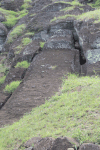



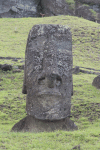
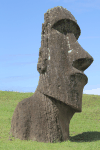

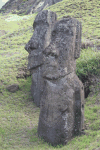

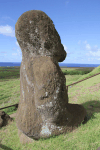
Puna Pau is the quarry where the red pukao (top knots) were carved.


Ahu Akahanga is a large ahu that was not restored. In the late 19th century all ahus looked like this, not one single moai was left standing on the island.






Ahu Akivi is one of the few ahus in the interior of the island. It is the only one where the moais face the ocean.

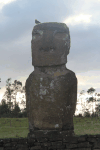
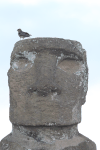
This ahu is located on the only sand beach of the island. It is the only ahu where most of the pukao (top knots) were replaced on the moais. The moais from this ahu were fairly well preserved, since they were buried in sand most of the time.



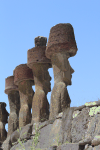
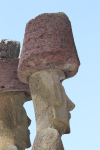
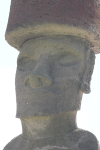


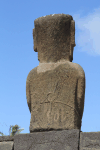
This complex with three ahus is close to the town. Ahu Ko Te Riku has the only moai with reproduced eyes.




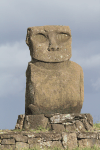
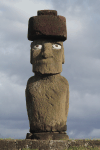
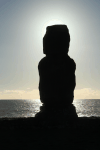



This ahu has the most moais, the tallest one (Paro), and the heaviest as well.

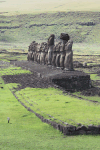



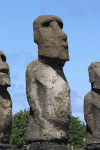
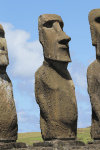
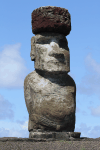
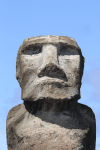
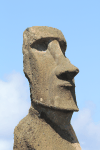
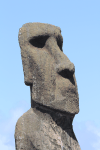
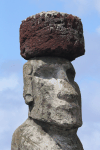
This page contains 78 pictures with 3 species
Page last updated on Sat Mar 6 16:04:22 2021 (Mountain Standard Time)
Page last updated on Tue Apr 23 12:53:18 2024 (Mountain Standard Time)
Rapa Nui (Easter Island) on soaring.guenther-eichhorn.com